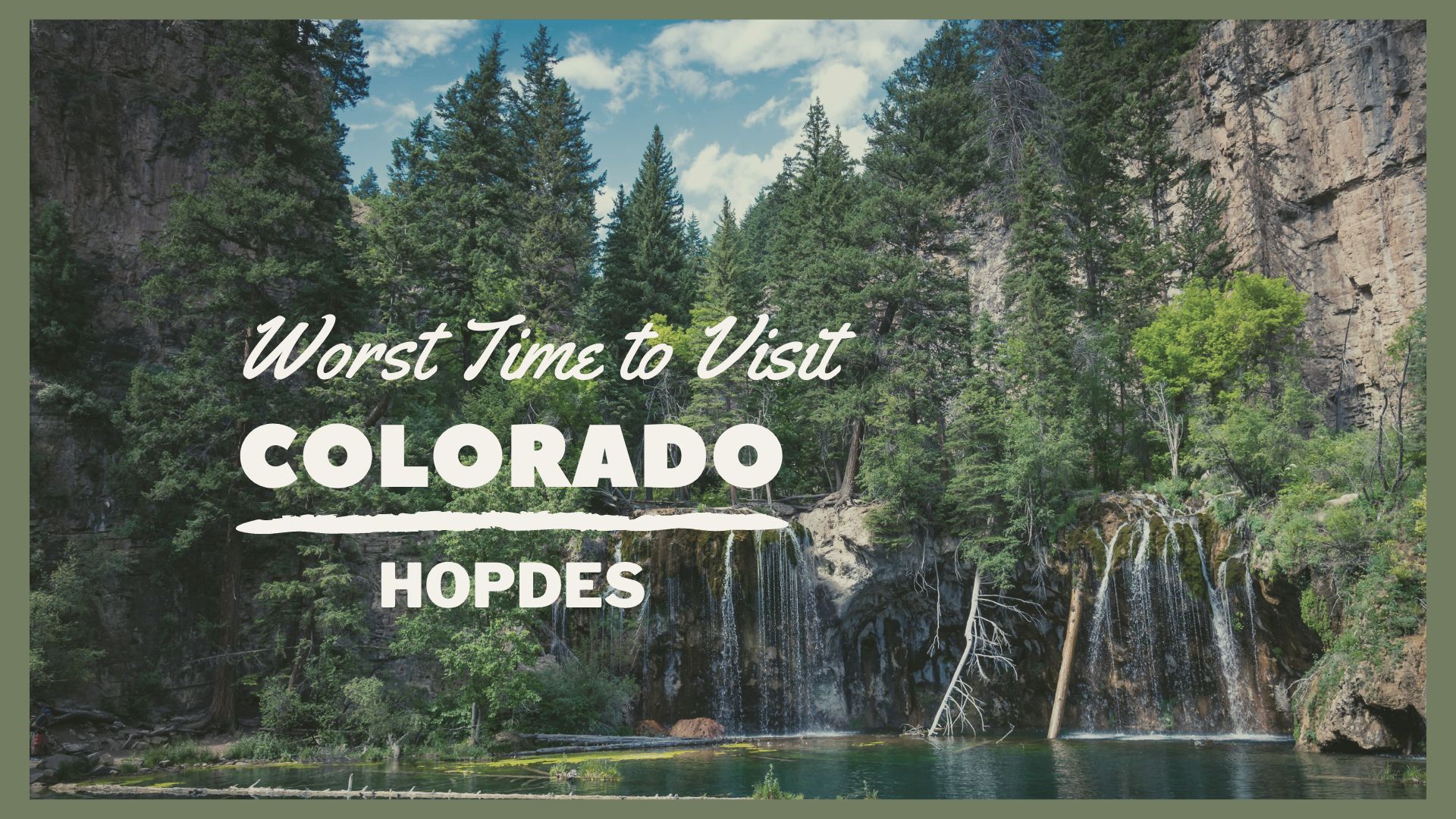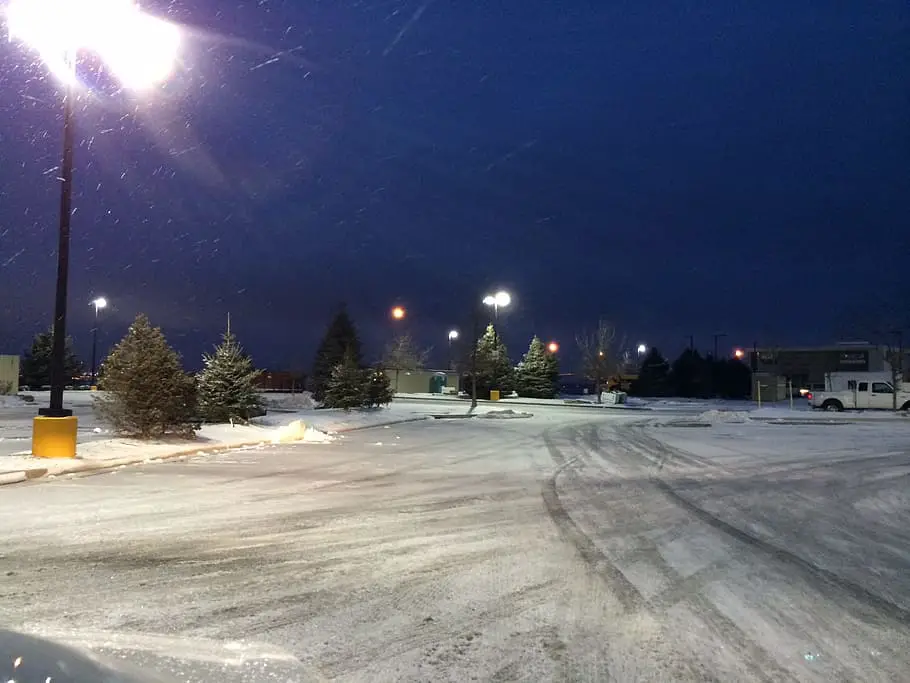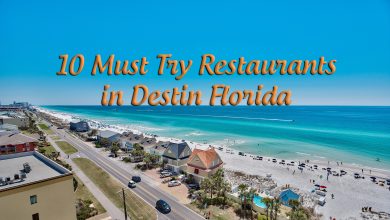
With its towering mountains, lush woods, and gushing rivers, Colorado is often considered to be among the most beautiful states in the United States. It is easy to see why so many tourists flock here every summer. Colorado has something for everyone, from some of the best skiing in the world to vibrant nightlife.
While Colorado is a fantastic vacation destination for most of the year, there are a few months when you should skip it. Travel and fun in Colorado might be hampered by fluctuations in population due to inclement weather, holidays, and major events. Let’s begin with our guide to the worst time to visit Colorado.
Check out the TOP 8 Mines in Colorado + Few Abandoned Mines [2023 Guide]
The Worst Time to Visit Colorado
The worst time to visit Colorado is during the months of January, February, and Early March because of extreme winter weather. In February, temperatures seldom get above freezing, averaging around 33 degrees Fahrenheit. Temperatures in March are just slightly higher than they are in February, averaging about 40 degrees Fahrenheit high and as low as 17 degrees Fahrenheit. The two months have a reputation for heavy snowfall as well.
The state receives an average of almost 13 inches of snow in February and an average of over 18 inches in March. Because of this, many locals have to contend with heavy snowfall and subzero conditions.
The longer evenings and shorter days of winter can make it tough to appreciate the season. The months of February and March are notoriously difficult for many individuals.
In addition, snow and ice often cover the roads and paths, making travel difficult and risky. Last but not least, throughout the winter months many of the state’s attractions are closed or have reduced operating hours. You should probably avoid visiting Colorado in the winter unless you really like the cold and don’t mind a few minor inconveniences.
Consider the following temperature forecast for Colorado before planning a trip!
Colorado Temperatures | Month-by-Month | Updated as Per National Weather Service | ||
| Month | Average High (°F) / (°C) | Average Low (°F) / (°C) |
| January | 40°F (4°C) | 15°F (-9°C) |
| February | 45°F (7°C) | 20°F (-7°C) |
| March | 50°F (10°C) | 25°F (-4°C) |
| April | 60°F (16°C) | 35°F (2°C) |
| May | 70°F (21°C) | 45°F (7°C) |
| June | 80°F (27°C) | 55°F (13°C) |
| July | 85°F (29°C) | 60°F (15°C) |
| August | 80°F (27°C) | 55°F (13°C) |
| September | 75°F (24°C) | 45°F (7°C) |
| October | 65°F (18°C) | 35°F (2°C) |
| November | 50°F (10°C) | 25°F (-4°C) |
| December | 40°F (4°C) | 15°F (-9°C) |
Still, Planning a Trip in Winters to Colorado? Consider These Aspects!
Colorado’s winters are known for their extreme cold and abundant snowfall. The snow and ice have closed several routes to Colorado. Here are some things to consider if you plan on visiting Colorado during the winter.
Frequent Snowfall
Extreme cold and snowfall totaling more than 120 inches (3048 millimeters) each year characterize the highlands, where snowfall is common and widespread. In February 2022, there were over 21 inches of snowfall making it quite difficult to move around.

Colorado’s winter temperatures can be bone-chilling. The state’s overall elevation contributes to arctic and subarctic climates in many mountainous areas, leading to frigid conditions. Even in lower-lying regions, temperatures regularly drop below freezing, making it essential to bundle up and prepare for cold weather activities.
Related Reading: Worst Time To Visit Miami According to Locals & Experts
Drive Safely
You should take all precautions while traveling to Colorado during the winter. Avalanches and snow may close access routes, making a visit to the area a potentially dangerous endeavor. If you must drive, it is recommended that you equip your car with all-weather tires and any other equipment, such as chains or tire studs that will increase traction on icy roads.

In addition, it is a good idea to let someone know where you are with your updated location and when you expect to be back just in case anything happens.
Travel Conditions
If you are planning to travel to Colorado in Winter, especially between December 23rd to January 2nd, you should know that this time has the peak traffic and congestion as this is the holiday season plus Christmas is just around the corner.

We recommend taking an update from the National Weather Service (Colorado) every time you plan to travel as they provide official forecasts.
Be Prepared
Get prepared for the cold with the right clothes and equipment. A strong coat, hat, gloves, and waterproof boots are all essential essentials. Extra blankets and warm clothing should be brought along in case you get trapped.

If you are going to be trekking or skiing in a location where avalanches are possible, you need to be aware of the risks and take appropriate safety measures. Always travel in groups and double verify the avalanche prediction before venturing out. If you or someone with you starts to feel cold, it’s important to know the signs of hypothermia and frostbite and how to treat them.
Editor’s Pick: Beautiful Waterfalls In Colorado To Experience Utmost Serenity
Other Worst Times to Go to Colorado
There are times of the year besides winter that are considered the worst times to visit Colorado
Peak Summers
Highs in the Front Range often exceed 95 degrees Fahrenheit (35 degrees Celsius) in the summer. In Colorado, the warmest month is often July. In the plains and the desert, the temperature may become quite hot during the summer. Highs in the state typically range from 78 to 94 degrees Fahrenheit (25.6 to 34.4 degrees Celsius).
Temperatures above 100 degrees Fahrenheit (37.8 degrees Celsius) are not uncommon, and many locations in Colorado experience temperatures of 95 degrees or more for many days in a row.

During this season, the plains are prone to flooding in the spring and summer owing to thunderstorms and melting snow, as seen by events like the Denver Flood of 1965 and the Colorado Floods of 2013.
Highs in the city often reach the high 90s during the summer, making it the most popular time for visitors. The higher demand causes prices to skyrocket, so expect to spend extra for everything from lodging to admission fees.
Read Next: Worst Time to Visit New York [Tips From Locals & Experts]
Wildfires in Summer
The wildfire season has sadly been getting worse. The air quality and visibility on the west coast may be significantly impacted by wildfires; however, the extent of this influence varies greatly from day to day.

Extreme wildfires, such as the Hayman Fire of 2002 (the biggest in American history at the time), are common throughout the summer because of the state’s generally dry climate. Besides, the 2013 Black Forest Fire destroyed hundreds of homes as well. Most recently, 2020 noticed the East Troublesome Fire which was one of the largest fires in Colorado’s history.
Earthquakes of magnitudes between 2 and 3.5 on the Richter scale happen frequently in Colorado.
Most Crowded and Expensive Months to Visit Colorado
The Colorado Department of Transportation reports that summer is the biggest travel season in Colorado. Several causes, including the return of students and the yearly uptick in tourists, have contributed to this.

The Colorado State Fair and the Denver Broncos’ training camp are only two examples of the many events that contribute to the increase in traffic. So, drivers need to be extremely careful and schedule their travels around these times.
- During summer, Hotels in Colorado cost on average $105 per night, ranging from $65 to $288, while weekly rentals of a whole property may cost anywhere from $200 to $580.
- In Colorado, a night out at a fancy restaurant with cocktails can easily cost $368 per person or more, whereas a wonderful supper at a more affordable place would just set you back $24.
When is The Worst Time to Visit Colorado: According to Other Tourists?
Hopdes board member, Zalah Khan said,” I wouldn’t recommend visiting Colorado in the month of February. It was dull because ski areas were closing their lifts and trails and businesses in mountain towns were emptying out as their patrons returned home”.
Sara Anwar suggests, “As December was winding down, I decided to pay Colorado a visit. The most costly and crowded state to visit was Colorado. Each resort has a hefty price tag. Without getting into the details, let’s just say that I overspent and under-enjoyed myself”.
Month-by-Month Analysis: Worst Month to Visit Colorado
If you are coming to Colorado or know someone making plans, use this month-by-month guide and decide on an appropriate month to go to Colorado based on your preferences, and also decide the worst time to visit Colorado for yourself.

January (Worst Time to Visit Colorado)
- Temperatures: Average high temperatures range from 40°F (4°C) to 50°F (10°C), while average low temperatures range from 15°F (-9°C) to 25°F (-4°C).
- Weather: Expect occasional snowfall and chilly conditions throughout the state. The mountains receive significant snowfall, making it ideal for winter sports.
- Activities: Skiing, snowboarding, snowshoeing, ice climbing, and ice skating are popular winter activities. Explore Colorado’s numerous ski resorts, such as Aspen, Vail, and Breckenridge.
- Special Events: Snow sculptures at the International Snow Sculpture Championships in Breckenridge. Winter festivals and ice festivals are held in various towns.
- Crowd Level: January sees a moderate crowd level due to the popularity of winter sports and ski vacations.
February
- Temperatures: Average high temperatures range from 40°F (4°C) to 50°F (10°C), while average low temperatures range from 15°F (-9°C) to 25°F (-4°C).
- Weather: Similar to January, February brings cold temperatures and regular snowfall, especially in the mountains.
- Activities: Skiing, snowboarding, snowmobiling, dog sledding, and ice fishing are popular. Enjoy après-ski activities and relax in cozy mountain lodges.
- Special Events: Winter festivals, ice climbing competitions, and Valentine’s Day events are held across the state.
- Crowd Level: February maintains a moderate crowd level, with visitors enjoying winter sports and winter-themed events.
March
- Temperatures: Average high temperatures range from 45°F (7°C) to 55°F (13°C), while average low temperatures range from 20°F (-7°C) to 30°F (-1°C).
- Weather: March marks the transition from winter to spring. Expect milder temperatures and occasional snowfall, especially in the mountains.
- Activities: Skiing, snowboarding, snowshoeing, and snowmobiling continue to be popular. Hiking, wildlife watching, and exploring town attractions become more feasible.
- Special Events: St. Patrick’s Day parades, spring festivals, and spring skiing events take place.
- Crowd Level: March sees a moderate crowd level, with winter sports enthusiasts and those looking to enjoy the early signs of spring.
April
- Temperatures: Average high temperatures range from 55°F (13°C) to 65°F (18°C), while average low temperatures range from 30°F (-1°C) to 40°F (4°C).
- Weather: Spring arrives with milder temperatures, but snowfall can still occur, especially in higher elevations.
- Activities: Hiking, biking, wildlife viewing, and exploring city attractions become more popular. Some ski resorts may close during this month.
- Special Events: Easter celebrations, Earth Day events, and cultural festivals are held across the state.
- Crowd Level: April sees a relatively lower crowd level compared to winter months, making it a great time to enjoy the outdoors with fewer tourists.
May
- Temperatures: Average high temperatures range from 65°F (18°C) to 75°F (24°C), while average low temperatures range from 35°F (2°C) to 45°F (7°C).
- Weather: May brings warmer temperatures and a significant decrease in snowfall. However, occasional rain showers are possible.
- Activities: Hiking, biking, whitewater rafting, fishing, and exploring national parks become popular. Wildflowers bloom, adding vibrant colors to the landscapes.
- Special Events: Cinco de Mayo celebrations, Memorial Day weekend events, and outdoor music festivals are held throughout the state.
- Crowd Level: May sees a moderate crowd level, as visitors take advantage of pleasant weather and outdoor activities.
June
- Temperatures: Average high temperatures range from 75°F (24°C) to 85°F (29°C), while average low temperatures range from 45°F (7°C) to 55°F (13°C).
- Weather: June marks the transition from spring to summer in Colorado. The weather is usually warm, and there can be occasional afternoon thunderstorms. Snowmelt from the mountains can lead to high water levels in rivers.
- Activities: Hiking, camping, fishing, and river rafting are popular, as are outdoor activities such as mountain biking and horseback riding. It’s a great time for wildlife viewing. Water levels in lakes and reservoirs are starting to rise, making it a good time for water activities.
- Special Events: The onset of summer in June brings with it various outdoor events like music festivals, farmers’ markets, and local town celebrations. The annual GoPro Mountain Games in Vail is a highlight of June.
- Crowd Level: June is the start of the tourist season, so expect increasing crowd levels. Popular destinations might start to get crowded, especially towards the end of the month.
July (Most Crowded Time to Visit Colorado)
- Temperatures: Average high temperatures range from 85°F (29°C) to 95°F (35°C), while average low temperatures range from 55°F (13°C) to 65°F (18°C).
- Weather: July brings warm and sunny weather, with occasional afternoon thunderstorms. It is the peak of summer in Colorado.
- Activities: Hiking, mountain biking, camping, fishing, river rafting, horseback riding, and exploring scenic drives are popular. Enjoy water activities on lakes and reservoirs.
- Special Events: Independence Day celebrations, Fourth of July parades, rodeos, and outdoor concerts are highlights of July.
- Crowd Level: July experiences a high crowd level, as it is the peak tourist season. Popular destinations can be crowded, especially around Independence Day.
August (Best Time to Visit Colorado)
- Temperatures: Average high temperatures range from 80°F (27°C) to 90°F (32°C), while average low temperatures range from 50°F (10°C) to 60°F (15°C).
- Weather: August continues to offer warm and sunny weather, with occasional afternoon thunderstorms. Days gradually become shorter.
- Activities: Hiking, mountain biking, camping, fishing, river rafting, hot air balloon rides, and attending outdoor festivals are popular. Explore Colorado’s scenic byways.
- Special Events: County fairs, music festivals, art shows, and cultural events take place across the state.
- Crowd Level: August experiences a high crowd level, as it is still part of the peak tourist season. Popular outdoor destinations can be busy, but less crowded than in July.
September
- Temperatures: Average high temperatures range from 70°F (21°C) to 80°F (27°C), while average low temperatures range from 40°F (4°C) to 50°F (10°C).
- Weather: September brings cooler temperatures and a transition towards autumn. The weather remains generally pleasant, with a slight increase in precipitation.
- Activities: Hiking, mountain biking, camping, fishing, scenic drives, wildlife viewing, and photography are popular. Witness the changing colors of autumn foliage.
- Special Events: Labor Day weekend events, harvest festivals, Oktoberfest celebrations, and fall art exhibits are held in various towns.
- Crowd Level: September sees a moderate crowd level, as the summer tourist season starts to wind down. It’s a great time to enjoy outdoor activities and fall scenery with fewer visitors.
October
- Temperatures: Average high temperatures range from 60°F (15°C) to 70°F (21°C), while average low temperatures range from 30°F (-1°C) to 40°F (4°C).
- Weather: October brings cooler temperatures and an increasing chance of snowfall, especially in higher elevations. It’s a transitional month towards winter.
- Activities: Hiking, mountain biking, camping, fishing, wildlife viewing, photography, and enjoying fall foliage are popular. Some ski resorts may open towards the end of the month.
- Special Events: Halloween celebrations, harvest festivals, pumpkin patches, and Oktoberfest events can be found in various towns and cities.
- Crowd Level: October experiences a moderate crowd level, with fewer tourists compared to the summer months. It’s a great time to enjoy fall activities and landscapes.
November
- Temperatures: Average high temperatures range from 45°F (7°C) to 55°F (13°C), while average low temperatures range from 20°F (-7°C) to 30°F (-1°C).
- Weather: November marks the transition into winter, with colder temperatures and increasing chances of snowfall throughout the state.
- Activities: Skiing, snowboarding, snowshoeing, ice skating, and enjoying hot springs are popular activities. Prepare for winter sports and enjoy the snowy landscapes.
- Special Events: Thanksgiving events, holiday craft fairs, and early winter festivals can be found in various communities.
- Crowd Level: November experiences a lower crowd level compared to the peak tourist season. The crowd begins to pick up towards the end of the month as ski resorts open.
December
- Temperatures: Average high temperatures range from 35°F (2°C) to 45°F (7°C), while average low temperatures range from 10°F (-12°C) to 20°F (-7°C).
- Weather: December brings cold temperatures and snowfall throughout Colorado, making it a winter wonderland. The mountains receive heavy snow.
- Activities: Skiing, snowboarding, snowshoeing, ice climbing, ice fishing, and enjoying winter festivals are popular. Embrace the holiday season in a snowy setting.
- Special Events: Christmas and holiday celebrations, winter festivals, and New Year’s Eve events take place across the state.
- Crowd Level: December experiences a moderate to high crowd level, particularly during the holiday season. Ski resorts and popular winter destinations can be crowded
Conclusion
Now that you have read our guide to the worst time to go to Colorado, you’ll be glad that you didn’t go there during peak rush, summers, or extreme winter seasons. Keep in mind that everyone might have different preferences and some adventure enthusiasts would still want to travel to Colorado during the winters. If you have plans for any other places, read out our other “When to Visit Guides” which are covered by our travel team, focusing on elements that may hinder an idealistic trip for you and your loved ones!
Worst Time to Visit Colorado - FAQs
Colorado offers a plethora of attractions, but some must-visit destinations include Rocky Mountain National Park, Mesa Verde National Park, Garden of the Gods, Pikes Peak, Maroon Bells, Great Sand Dunes National Park, and the town of Aspen.
The busiest times to visit Colorado are during the peak tourist seasons, such as the summer months (June to August) and major holidays like July 4th and Christmas/New Year’s.
Visiting during shoulder seasons, such as early spring (before spring break), late fall (after the peak foliage season), and non-holiday weekdays can offer a less crowded experience in Colorado. Additionally, consider exploring lesser-known destinations or off-the-beaten-path attractions to avoid heavy crowds.





